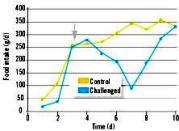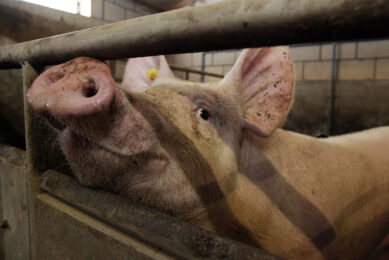Performance during pathogen challenge

Whether maximum performance is achieved depends on the composition of the feed and the environment in which the pig is kept. But how is the feed intake and thus growth and performance influenced when pigs are exposed to infectious pathogens? Ilias Kyriazakis gives us an insight.
show a (temporary) reduction in feed intake, henceforth called anorexia.
Sandberg et al. (2006) have proposed that there are at least two functional
mechanisms that may lead to a reduction in feed intake during exposure to
pathogens:
protein
retention of the challenged animals is reduced, and
2) the
reduction in feed intake is a direct consequence of
the exposure to
pathogens.
Black et al. (1999) have argued that both mechanisms may
be acting simultaneously. The rate of development of anorexia is greatly
dependent upon the type of pathogen to which the pig is exposed and its dose.
This has indeed been observed by both Houdijk et al. (2007) and Fraser
et al. (2007) who have shown that low doses of bacterial pathogens such as
Escherichia coli and Salmonella enterica either do not result
in anorexia, or pigs need repeated doses of these pathogens for a reduction in
feed intake to be observed. Similarly the extent of anorexia is greatly affected
by pathogen type and its dose. Higher pathogen doses lead to very dramatic
decreases in the feed intake and even complete cessation of feeding (Black et
al., 1999). Duration of anorexia can be very short, as shown in the cases of
exposure to Salmonella typhimurium (Turner et al., 2002) and
the porcine reproductive and respiratory syndrome (PRRS) virus (Greiner et
al.,
2000). On the other hand, duration of anorexia can last for several days or
weeks for gastrointestinal parasite challenges (Hale, 1985).
Professor Ilias Kyriazakis is the head of the Animal Nutrition
and Health Department at the Scottish Agricultural College in Edinburgh,
Scotland and the Professor of Animal Science at the Veterinary School of the
University of Thessaly in Greece. He has 20 years research experience in pigs
and he is particularly interested in the consequence of management on their
performance, health and welfare. His recent work deals with the interactions
between nutrition and the immune response in livestock.
There is some evidence in the
literature that the composition of the feed offered to pigs exposed to pathogens
may affect the characteristics of anorexia. In experiments by Williams et
al. (1997a), pigs were offered ad libitum feeds of
different protein (lysine) contents in environments intended to have either high
or low levels of “stimulation of the immune
system” (Table 1). This was achieved by
exposure to a “dirty environment”, in the absence of dietary antimicrobials and
through repeated vaccination. The data suggest that as the lysine content of the
feed was reduced the difference in the feed intake between the “control” and
“immune stimulated” pigs was reduced; the feed intake of these two groups of
pigs was identical at the lowest level of lysine. This effect can be accounted
for by the fact that at the lowest level of lysine the feed intake of the
“control” pigs was reduced compared to the intake of the control pigs on the
highest lysine level. Wellock et al. (2003 b) have suggested that the
inability of the pigs to increase their feed intake on the low lysine feed is
due to their inability to cope with the excess energy intake that would
accompany this situation. Feed intake of pigs on the lowest lysine level was
thus constrained. Stimulation of the immune system would not reduce any further
the already constrained actual feed intake. Different conclusions on the effect
of feed composition on the extent and duration of anorexia may be drawn when
comparisons between control (uninfected) and infected pigs are made at a weight
or a time basis. This can be accounted for by the different growth trajectories
of the control and infected pigs, which in turn may have direct effects on their
feed intake. Thus, for a fair comparison, control and infected pigs may best be
compared at either the same body weight, or through scaling feed intake relative
to body weight.
In the experiment of Williams
et al. (1997a) the associated increase in maintenance requirements for
protein of challenged pigs was approximately twice as much as that of their
controls. The same magnitude of increase was seen in the experiment of Williams
et al. (1997b) on bigger pigs whose immune system was challenged
through the same methodology. Experiments of Fagbemi et al. (1991) and
Otesile et al. (1991) measured the energy retention of pigs challenged
with the same dose of Trypanosoma brucei at two different liveweights.
The 10 kg pigs had a greater increase in maintenance requirements for energy
(2.2 times the healthy controls), than the 100 kg pigs, that had maintenance
requirements 1.7 times the healthy controls. Pathogen challenges may also cause
increased requirements for protein due to the requirements for the immune
response, and the repair and replenishment of damaged tissues. Given that the
stimulation of the effector mechanisms of the immune response will depend on the
nature of the pathogen challenge, it is reasonable to suggest that both pathogen
type and dose will affect maintenance protein requirements. Increases in energy
requirements during a pathogen challenge may arise from the functioning of the
immune system, the cost associated with damage and repair (such as additional N
processing) and expression of fever. In the case of gastrointestinal parasites,
the most significant energetic cost appears to be associated with damaged
tissues resulting in additional amounts of N appearing in the urine (MacRae
et al., 1982).Such costs have not been estimated directly on pigs, but
would be expected to contribute to a reduced efficiency of feed use.
Figure 1 – The effect of challenge with 108 colony forming
units of enterotoxigenic Escherichia coli on the feed intake of control and
challenged pigs over a 10-day period post weaning (Houdijk et al, 2007). The
arrow indicates the point of infection
Unfortunately, there is a lack
of suitable experiments that observed the growth of pigs during recovery from
exposure to pathogens. Experiments with feed restricted pigs showed that a
period of healthy low feed intake leads to similar body composition changes to
pigs whose feed intake has been reduced due to pathogen induced anorexia
(Bassaganya-Riera et al., 2001; Escobar et al., 2004). In such
instances the pigs will be expected to attempt to restore their fatness to a
level determined by their genotype; in other words they would show compensatory
fattening (Stamataris et al., 1991). Providing that the period of
recovery is sufficiently long, this compensatory fattening should result in the
same end lipid weights in the carcass (Kyriazakis and Emmans, 1992). The issue
of whether pigs will also show compensatory growth in protein gain and thus
reduce some of the time lost during the period of feed restriction is more
contentious. Kyriazakis and Emmans (1992) have summarised an extensive body of
literature on growth following realimentation in pigs and concluded that
compensatory growth in protein of skeletal muscle does not seem to exist. In
other words, time lost in the growth of muscle protein can never be regained. A
compensatory gain in lipid and no compensatory gain in body protein will
manifest as compensatory liveweight gain during recovery until body fatness is
restored. On the other hand, if the level of fatness has been undisturbed by the
exposure to pathogens, then liveweight gain will not show any compensatory gain.
In order to restore any
differences in its composition at the point of recovery from the uninfected
controls, the pig will need to modify its feed intake. If the pig attempts to
show compensatory fattening, as suggested above, then the expectation is that
the pig will also increase the rate of its feed intake. The extent of the
increase will depend on the level of fatness at the point of recovery
(Stamataris et al., 1991). It has not been possible to identify
suitably designed experiments that have measured feed intake during recovery in
pigs previously exposed to pathogens. This is because, in most cases, the point
of recovery can not be clearly identified and the
feed intake of animals is
reported over a period of time that includes both anorexia and recovery. The
rate of feed intake that enables restoration of the body composition will depend
on the composition of the feed, the digestive capacity of the pig and the
environment it is kept in (Stamataris et al., 1991). An increase in
feed intake will also increase the amount of heat production by the pig and for
this reason the ambient temperature may define the extent of this increase
(Wellock et al., 2003a).
In the literature of compensatory growth, the conditions of realimentation are
considered
| |
| Pathogen challenges can cause increased protein requirements due to the requirements for the immune response, and the repair and replenishment of damaged tissues. |
responsible for the confusion that
exists over the issue of if and how quickly pigs overcome the abnormalities in
their body composition (Kyriazakis and Emmans, 1992). Here it is suggested that
the environmental requirements of a pig that is recovering from exposure to
pathogens may be very different from an uninfected pig. A special case to
consider is the feed intake of the pig that continues to be exposed to pathogens
following recovery. This is a realistic scenario, as exposure to most pathogens
is a constant feature of commercial practice. On the basis of the arguments
developed in previous sections, this stimulation of the immune system will be
associated with an increased nutrient requirement, even for a fully immune pig.
This increase in requirements will be expected to be manifested as an increase
in feed intake. The extent of the increase will depend on the pathogen type and
its dose, as discussed above. It has not been possible to identify relevant
experiments to support this suggestion. It would be useful to investigate this
issue, as it may affect the requirements of a pig continuously exposed to
pathogens.
The effects of
pathogens on pig performance are common across pathogen types and doses (e.g.
degree of anorexia during subclinical disease). However, to be able to better
predict the effect of pathogens on feed intake, growth and performance needs to
be understood even more. This can be achieved by closer communication between
pig breeders and other animal scientists, such as nutritionists and
veterinarians. Similarly, the characterisation of the pig’s immune response has
been a consistent limitation in our understanding of how animals deal with
pathogens and has had implications upon our ability to enhance them. For
example, under what circumstances can the immune response of a pig be enhanced
through nutrition? Recent advances in the characterisation and quantification of
the immune response should enable progress on this subject to be made. In
addition, consumer concerns, legislation and pathogen resistance to drugs will
probably increase the interest in the understanding of the performance of
animals in the presence of pathogens. A framework that accounts for the
performance of pigs during exposure to pathogens may then have a value in the
developments of strategies, including nutritional and breeding ones, to deal
with this challenge. <-
“Food intake
and performance of pigs during health, disease
and recovery”, presented at
the Nottingham
International pig conference.
References are available on
request.
Join 26,000+ subscribers
Subscribe to our newsletter to stay updated about all the need-to-know content in the feed sector, three times a week. Beheer
Beheer









 WP Admin
WP Admin  Bewerk bericht
Bewerk bericht